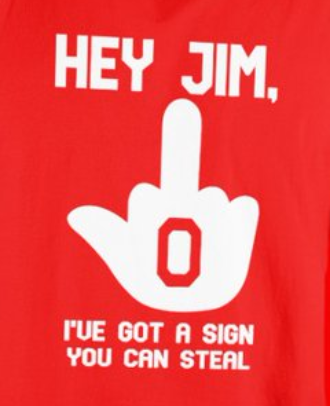
The Toledo War - A War That Is Settled Every Year - On The Gridiron.
Led by Michigan's feisty 22 year old Territorial Governor, Stevens T. Mason, a small 250-person group of volunteers moved toward Toledo to defend their territory from an Ohio take-over.
The Northwest Ordinance of 1787 established an east-west line drawn from the southern tip of Lake Michigan across the base of the peninsula. The original line was drawn using maps that showed the line intersecting Lake Erie north of the Maumee River. This is the territorial "line-of- scrimmage" that Ohioans recognized when their constitution was drafted in 1803. When the Michigan Territory was created in 1805, surveyors realized the tip of Lake Michigan was actually further south and included the area that would later become Toledo.

This revelation had the Ohioans in Congress screaming, "Offsides!" They immediately campaigned to have the northern line accepted as the official border. In 1817, U.S. Surveyor General, and former Ohio governor, Edward Tiffin, sent William Harris out to survey the line according to Ohio's constitution. The Michigan Territorial Governor, Lewis Cass, went to President James Monroe to protest the call. John A. Fulton was called into the fray to make another survey of the disputed claim in accordance with the Northwest Ordinance.
It was not surprising that the two surveys resulted in two lines eight miles apart at Lake Erie and five miles apart at the Indiana border, with a total of 468 square miles in between. Although Ohio still claimed the Toledo Strip as its own, the squabbling momentarily ceased and Michigan quietly assumed jurisdiction over the area.
The controversy heated up again when Michigan sought admission to the union on December 11, 1833. In spite of Michigan's presence in the Toledo Strip, Ohio Congressmen successfully lobbied to block Michigan's acceptance as a state until it agreed to Ohio's version of the boundary. Massachusetts Representative, and former President, John Quincy Adams, supported Michigan saying, "Never in the course of my life have I known a controversy of which all the right so clearly on one side and all the power so overwhelmingly on the other."
Ohio's position was so strong that Governor Robert Lucas refused to negotiate with Michigan over the issue. Michigan's territorial council countered by passing a resolution that would impose heavy fines on anyone other than Michigan or federal officers trying to exercise jurisdiction in the Toledo Strip. In a blatant act of defiance, Governor Lucas turned the disputed region into a county named after himself and appointed a sheriff and judge. Michigan's "boy governor" had had enough! Stevens T. Mason mobilized his troops and headed towards Ohio. The Toledo War had begun.
The War involved more saber-rattling and one-upmanship than it did shooting and blood-letting. For instance, after the Ohio legislature voted to approve a $300,000 military budget, Michigan upped the ante by approving one with $315,000. Michigan's militia did end up arresting some Ohio officials, capturing nine surveyors, and firing a few shots over the heads of others as they ran out of the area. But only Ohio inflicted any casualties, when a buckeye named Two Stickney stabbed a Michigan Sheriff during a tavern brawl.
When President Andrew Jackson stepped in, the war ended. Jackson removed Mason from office and the militia commander, General Joseph W. Brown disbanded his troops. But Congress still held Michigan statehood hostage until it agreed to Ohio's claims. The citizens of Michigan set up a state government anyway, and elected Stevens T. Mason governor.
Michigan eventually became the 26th state of the union, on the 26th of January, 1837. But its territory did not include the Toledo Strip. Instead, it gained title to the western three-quarters of the upper peninsula as compensation; 9,000 square miles of the most valuable timber, iron, and copper country in America.
Like so many of the gridiron battles that continue to rage today, a game isn't decide on one play, but a series of plays. Poor officiating may have taken Michigan officially out of the campaign for the Toledo Strip, but in retrospect, it's obvious who won the War.







